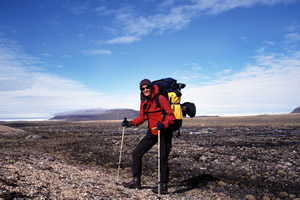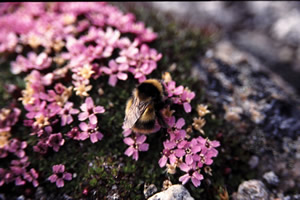Mon July 26:
Its mid morning when I stir. Alfred is still burrowed deep in his bag…I give him another ½ hour then gently nudge him but don’t get the response I expect: he slides further down in to his bag! Usually, he is the one hopping up and out first thing. “Hey Alfred” I say…”ugh, I feel sick” is the reply. So starts the day….
So my turn to be nurse. After coffee and soup, we mull the situation. The weather is uninspiring with cold wind, fog and clouds washing down from the table lands to the low lands where we camp – feels like cold glacier air! Alfred wants to try crossing the river in spite of feeling poorly and never an enthusiastic water rat like myself.
 We break camp and walk upstream along the same bank we inspected last night. With our overshoes on, I’m hoping we can splash or rock hop over a wider but shallow area. The river does fan out across a gravel island, this is the best place yet. It’s a challenging 200 metres across fast flowing current with a rolling rock bottom. The occasional rock pokes above the water, hopefully not too slippery. I manage to cross OK but somehow water got inside Alfred’s overshoes and his feet are wet. But with foresight, he wore only socks, and his boots are dryly hanging around his neck. Thus, happily we are over this obstacle and proceed further towards Cape Hardy.
We break camp and walk upstream along the same bank we inspected last night. With our overshoes on, I’m hoping we can splash or rock hop over a wider but shallow area. The river does fan out across a gravel island, this is the best place yet. It’s a challenging 200 metres across fast flowing current with a rolling rock bottom. The occasional rock pokes above the water, hopefully not too slippery. I manage to cross OK but somehow water got inside Alfred’s overshoes and his feet are wet. But with foresight, he wore only socks, and his boots are dryly hanging around his neck. Thus, happily we are over this obstacle and proceed further towards Cape Hardy.

The day is warming up, it’s about +8C…with the wind at our backs, its most pleasant. Walking is easy, the firm gravel of the raised beaches gentle underfoot. Many musk ox, at least 50, are scattered on the plains below feeding on grasses between the ponds. The ideal camp site (wind shelter, hidden from ocean view and close to a pond for water) appears at the base of small rocky knoll. Later I will climb to the top - its a natural look with good cover from many large boulders – how convenient to spy on the neighbours from here!
Start to explore by heading up and inland…everywhere is fresh musk ox dung as well as a sea of old pellets. Old bleached bones with large skulls, horns are tucked into grassy hollows, staring out as I pass by. The tundra creeps over these remnants and I leave the dead to their dreams. Foxes yip from somewhere, behind a pile of rocks: I catch sight of a flash of blond coat as it dashes by. Two animals, backlit by the sun, glow with halos of soft fur. A raven is started by the foxes, and flies off, perching on top a nearby boulder. I wonder what set off the foxes and then raven? Yesterday I found an almost whole goose egg and left it just outside the tent – a group of ravens came into camp early this morning and further pecked open the egg – predated a 2nd time. Nothing is safe from their sharp eyes.
After a late (7:30pm) lunch and tea, I want to show Alfred some whale bones I found. It’s a unique find, not just the back of a skull or rib but many bones including lots of large vertebra, all recently washed out by a small rivulet by the spring melt. Lodged higher up in the sandy bank, I find more bones buried under 6” of soil and part exposed – perhaps I’ll find the tusk of a woolly mammoth….I’m always looking, hoping to see the unusual.
It’s a glorious sun set, at this elevation, we are subjected to the arctic royal treatment. A low cloud bank obscures the sun itself but a fireball of rays shoots up from behind, lighting the sky and sea, reflecting golden off still pond waters below us, on flats below. Cape Sparbo is wonderfully back lit and Ellesmere Island is unusually clear and close seeming – Cone Mountain is stands out, 80 kilometers away. There is a micro second of direct sun hit, too fast for a photo but captured by the minds’ eye. Behind camp, having seen it all before, an old one horned bull wanders close to camp, shaggy, alone and indifferent to the glory.